By Leen Randell
Updated: Jul 04, 2024
10 Best Herbal Decoctions For Phlegm
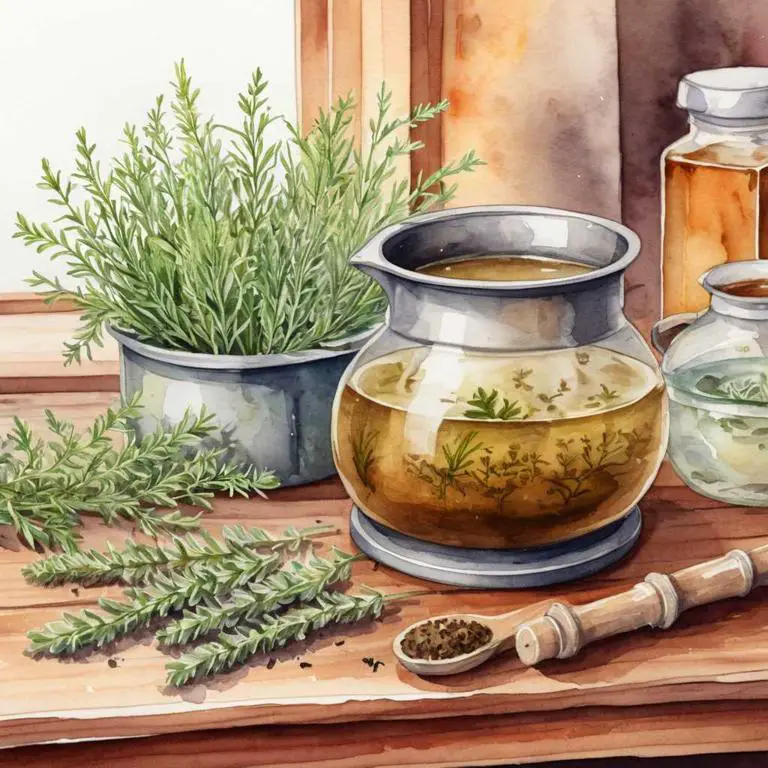
Herbal decoctions for phlegm are a natural remedy that combines the medicinal properties of herbs to relieve respiratory issues caused by excessive mucus production.
By steeping specific herbs in hot water, these decoctions help to break down and eliminate excess phlegm, providing relief from congestion, coughing, and wheezing. Examples of herbal decoctions that effectively combat phlegm include ginger, eucalyptus, and peppermint, which can be sipped on as a warm tea or added to steam inhalations for instant relief.
This natural remedy has been known to significantly improve the quality of life for those suffering from chronic respiratory issues, allowing them to breathe easier and enjoy daily activities without discomfort.
The following article describes in detail the most important decoctions for phlegm, including medicinal properties, parts of herbs to use, and recipes for preparations.
- 1. Lobelia inflata
- 2. Thymus vulgaris
- 3. Glycyrrhiza glabra
- 4. Pimpinella anisum
- 5. Asclepias tuberosa
- 6. Echinacea angustifolia
- 7. Solidago virgaurea
- 8. Mentha x piperita
- 9. Salvia officinalis
- 10. Ginkgo biloba
- What is the best combination of herbal decoctions to use for phlegm?
- What ailments similar to phlegm are treated with herbal decoctions?
1. Lobelia inflata
Indian tobacco decoctions helps with phlegm because of its natural expectorant properties, which loosen and clear mucus from the respiratory tract.
The herbs used in these decoctions, such as Lobelia inflata and other botanicals, have a soothing effect on irritated mucous membranes, reducing inflammation and congestion. As the phlegm is broken down, it becomes easier to cough up, providing relief from persistent coughing and chest congestion.
This natural approach can be particularly beneficial for individuals suffering from chronic respiratory conditions or seasonal allergies.
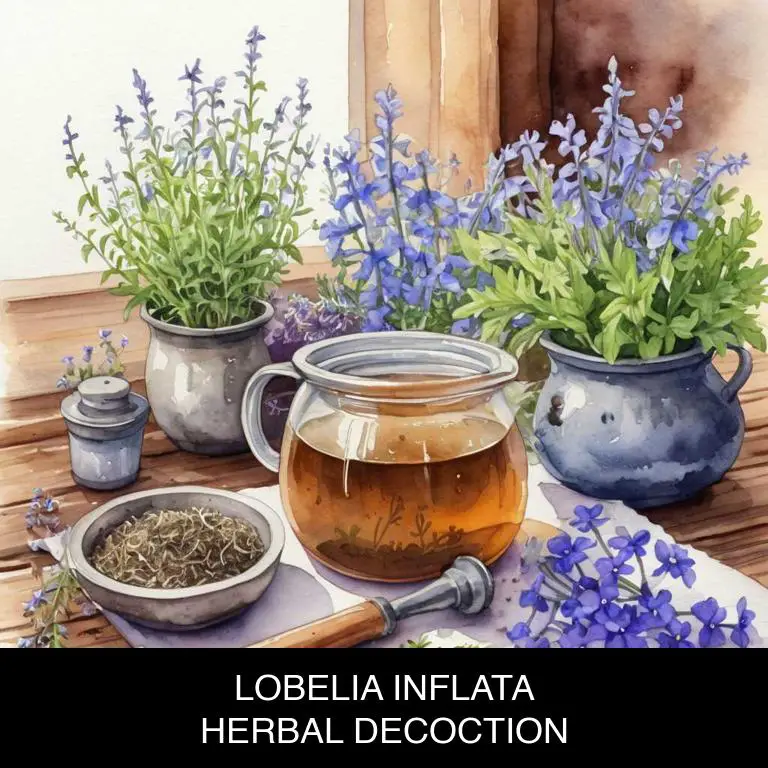
Medicinal Constituents
The list below shows the primary medicinal constituents in Lobelia inflata decoctions that help with phlegm.
- Alkaloids: Help with phlegm by acting as a bronchodilator, relaxing airway muscles and making it easier to expel mucus.
- Terpenoids: Contribute to phlegm relief by exhibiting expectorant properties, increasing the production of surfactants in mucus, making it easier to cough up.
- Saponins: Aid in phlegm relief by acting as surfactants, reducing the surface tension of mucus, and making it easier to expel from the respiratory tract.
Parts Used
The list below shows the primary parts of indian tobacco used to make decoctions for phlegm.
- Leaves: They are used for decoctions due to their ability to help relieve respiratory issues associated with phlegm.
- Roots: They are used for decoctions because of their expectorant properties that can aid in the removal of phlegm from the respiratory system.
- Seeds: They are used for decoctions as they contain compounds that can help to reduce inflammation and alleviate congestion associated with phlegm.
Quick Recipe
The following recipe gives a procedure to make a basic indian tobacco for phlegm.
- Gather dried lobelia inflata leaves and flowers in a ratio of 1 part herb to 8 parts water for the decoction.
- Combine the dried herb mixture with 8 parts water in a saucepan and bring to a boil over high heat for 5 minutes.
- Reduce heat to low and simmer for 10 to 15 minutes to allow the herbs to infuse into the water.
- Strain the decoction through a cheesecloth or a fine-mesh sieve into a clean container to remove the solids.
- Store the decoction in the refrigerator and consume within 24 hours or freeze for later use.
2. Thymus vulgaris
Thyme decoctions helps with phlegm because it possesses natural expectorant properties that loosen and clear out excess mucus from the respiratory tract.
The essential oils present in thyme, such as thymol and carvacrol, help to break down phlegm, making it easier to cough up and expel.
Additionally, thyme decoctions have anti-inflammatory effects that soothe irritated airways and reduce congestion, providing relief from symptoms of bronchitis, asthma, and chronic coughs.
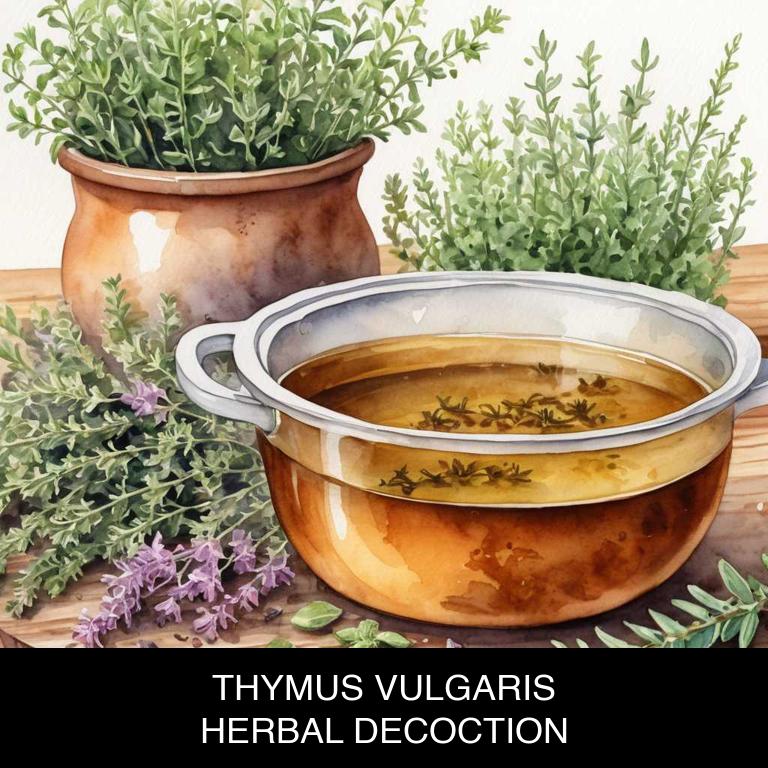
Medicinal Constituents
The list below shows the primary medicinal constituents in Thymus vulgaris decoctions that help with phlegm.
- Carvacrol: Carvacrol has been shown to help break down and expel phlegm due to its ability to thin mucus and improve respiratory function.
- Thymol: Thymol has antimicrobial and expectorant properties, which help to reduce inflammation and clear phlegm from the lungs, making it easier to breathe.
- Rosmarinic acid: Rosmarinic acid has anti-inflammatory and antioxidant properties, which can help to reduce the viscosity of phlegm and alleviate congestion in the respiratory tract.
Parts Used
The list below shows the primary parts of thyme used to make decoctions for phlegm.
- Leaves: Used due to their high concentration of thymol, a natural decongestant that helps reduce phlegm.
- Stems: Employed for their anti-inflammatory properties, which aid in relieving congestion caused by excessive phlegm.
- Barks: Utilized for their expectorant qualities, helping to loosen and clear phlegm from the respiratory system.
Quick Recipe
The following recipe gives a procedure to make a basic thyme for phlegm.
- Harvest fresh or dried thymus vulgaris leaves in the morning when the plant is at its highest essential oil content.
- Dry the harvested leaves in a single layer at room temperature for 7 to 14 days to preserve the herb.
- Combine 1 to 2 teaspoons of dried thymus vulgaris leaves with 1 cup of boiling water in a heat-resistant glass cup.
- Steep the mixture for 5 to 10 minutes to allow the active compounds to infuse into the water.
- Strain the decoction through a cheesecloth or a fine-mesh sieve into a clean glass container to remove the solids.
3. Glycyrrhiza glabra
Licorice decoctions helps with phlegm because it has natural anti-inflammatory properties that soothe and calm irritated mucous membranes, reducing congestion and mucus production.
The decoction's glycyrrhizin component also possesses expectorant qualities, helping to loosen and clear excess phlegm from the lungs, making it easier to expel.
Additionally, licorice root has natural demulcent properties that coat and protect the mucous membranes, providing relief from coughing and hacking associated with respiratory issues.

Medicinal Constituents
The list below shows the primary medicinal constituents in Glycyrrhiza glabra decoctions that help with phlegm.
- Licoricidin: Licoricidin has been found to have anti-inflammatory properties, helping to reduce mucus production and alleviate congestion associated with phlegm.
- Isoliquiritigenin: Isoliquiritigenin exhibits anti-inflammatory and expectorant properties, which can help to thin and clear mucus, making it easier to expel phlegm from the respiratory tract.
- Licopyranocoumarin: Licopyranocoumarin has been found to have expectorant properties, which can help to loosen and clear mucus from the lungs and airways, reducing phlegm accumulation.
Parts Used
The list below shows the primary parts of licorice used to make decoctions for phlegm.
- Roots: The roots of Glycyrrhiza glabra are commonly used due to their high glycyrrhizin content, which helps to break down phlegm and reduce congestion.
- Stems: The stems of the plant are often used to make decoctions that aid in expectoration and relieve phlegm due to their mild anti-inflammatory properties.
- Leaves: The leaves of Glycyrrhiza glabra are used in decoctions to help relieve coughs and congestion, as they contain compounds that help to thin and clear phlegm.
Quick Recipe
The following recipe gives a procedure to make a basic licorice for phlegm.
- Gather 2 to 5 grams of dried roots of glycyrrhiza glabra and clean them thoroughly with a soft brush.
- Combine the cleaned roots with 1 liter of boiling water to create a decoction.
- Reduce the heat to a simmer and let the mixture cook for 10 to 15 minutes.
- Strain the decoction through a cheesecloth or a fine-mesh sieve into a clean container.
- Store the decoction in a sealed container in the refrigerator for up to 3 days.
4. Pimpinella anisum
Anise decoctions helps with phlegm because it contains compounds that have natural expectorant properties.
The volatile oils in anise, such as anethole and apiol, help to loosen and clear mucus from the lungs and airways, making it easier to cough up and breathe more easily. Additionally, anise's warming and soothing effects can help to reduce congestion and inflammation, providing relief from sinus pressure and discomfort.
By promoting a healthy flow of mucus, anise decoctions can aid in the body's natural process of clearing out phlegm and other excess mucous secretions.
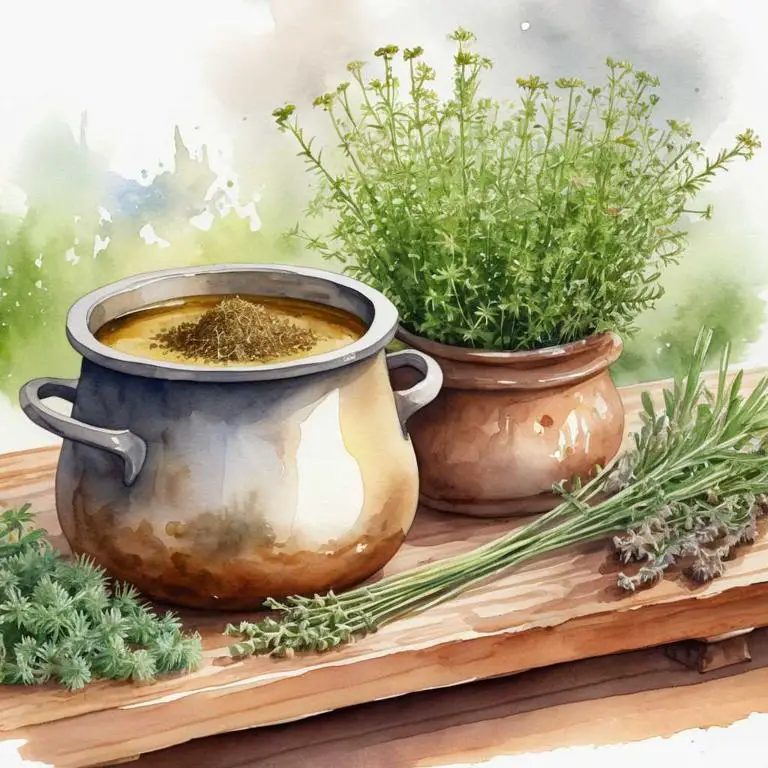
Medicinal Constituents
The list below shows the primary medicinal constituents in Pimpinella anisum decoctions that help with phlegm.
- Anethole: Anethole is a terpene that has expectorant properties, helping to thin and loosen phlegm, making it easier to cough up.
- Ligustilide: Ligustilide is a sesquiterpene that has anti-inflammatory and spasmolytic effects, which can help reduce inflammation and relax airway muscles to facilitate the expulsion of phlegm.
- Phenolic acids: Phenolic acids, such as ferulic acid, have antioxidant and anti-inflammatory properties, which can help reduce oxidative stress and inflammation in the airways, making it easier to manage phlegm.
Parts Used
The list below shows the primary parts of anise used to make decoctions for phlegm.
- Seeds: Used due to their high oil content and anise-like flavor, which helps to relieve cough and promote expectoration.
- Roots: Used due to their ability to stimulate digestion and relieve respiratory issues, such as cough and bronchitis.
- Leaves: Used due to their carminative properties, which help to ease digestive discomfort and relieve respiratory issues, such as cough and congestion.
Quick Recipe
The following recipe gives a procedure to make a basic anise for phlegm.
- Gather 20-30 grams of dried pimpinella anisum and store it in an airtight container for future use.
- Bring 1 liter of water to a boil in a saucepan over high heat for 5 minutes.
- Add the dried pimpinella anisum to the boiling water and reduce the heat to low.
- Simmer the mixture for 10-15 minutes or until the liquid has reduced to 200-250 milliliters.
- Strain the decoction through a cheesecloth or fine-mesh sieve into a clean glass container.
5. Asclepias tuberosa
Butterfly milkweed decoctions helps with phlegm because it contains a unique blend of natural compounds, including isopimaric acid and ursolic acid, which have been shown to exhibit expectorant properties.
These compounds help to loosen and clear excess mucus from the respiratory tract, providing relief from congestion and coughs.
The decoction also has anti-inflammatory effects, reducing swelling in the nasal passages and sinuses, allowing for easier breathing and a clearer mind.
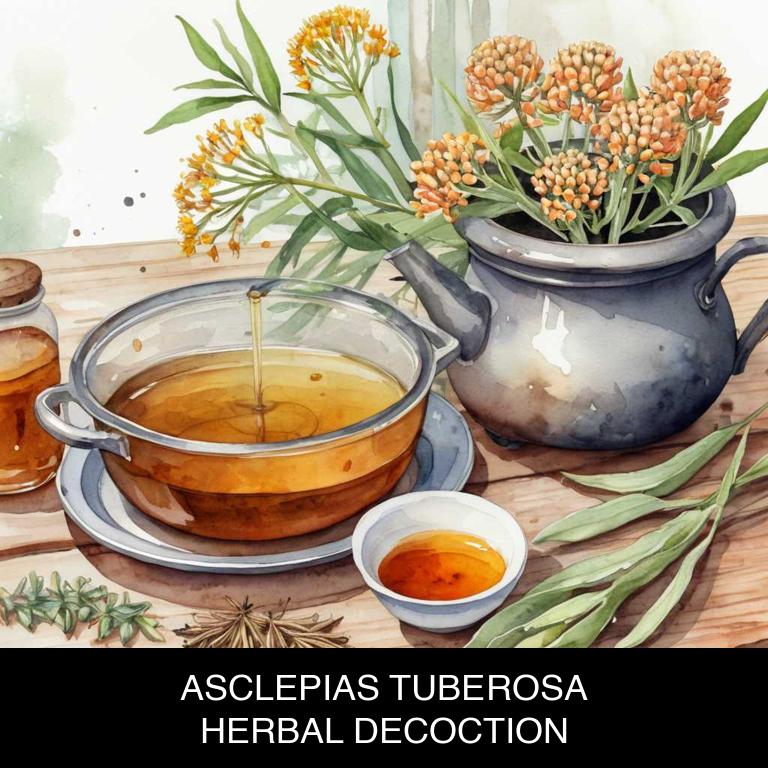
Medicinal Constituents
The list below shows the primary medicinal constituents in Asclepias tuberosa decoctions that help with phlegm.
- Cardenolides: These cardiac glycosides have anti-inflammatory properties that help reduce swelling and alleviate congestion associated with excess phlegm.
- Asclepin: This flavonoid glycoside has been shown to exhibit expectorant properties, helping to loosen and clear phlegm from the respiratory system.
- Iridoid glycosides: These compounds have been found to possess anti-inflammatory and bronchodilatory effects, which can help alleviate respiratory issues caused by excess phlegm.
Parts Used
The list below shows the primary parts of butterfly milkweed used to make decoctions for phlegm.
- Roots: The roots of Asclepias tuberosa are commonly used for decoctions to relieve phlegm due to their medicinal properties.
- Leaves: The leaves of Asclepias tuberosa are often used in decoctions to relieve phlegm due to their ability to help clear respiratory passages.
- Stems: The stems of Asclepias tuberosa can be used to make decoctions that relieve phlegm by providing expectorant properties.
Quick Recipe
The following recipe gives a procedure to make a basic butterfly milkweed for phlegm.
- Gather 25 grams of dried asclepias tuberosa root and 5 grams of dried flowers.
- Grind 10 grams of the dried root into a fine powder using a mortar and pestle.
- Combine the ground root powder with 500 milliliters of boiling water in a saucepan.
- Steep the mixture for 20 minutes and then strain it through a cheesecloth.
- Store the decoction in the refrigerator for up to 3 days before use.
6. Echinacea angustifolia
Kansas coneflower decoctions helps with phlegm because of its unique ability to soothe and calm irritated mucous membranes.
The anti-inflammatory properties of the herb, Echinacea purpurea, work to reduce swelling and congestion, making it easier for the body to expel excess mucus.
Additionally, Kansas coneflower has natural expectorant properties, which help to loosen and clear out phlegm, providing relief from coughs, wheezing, and chest congestion.
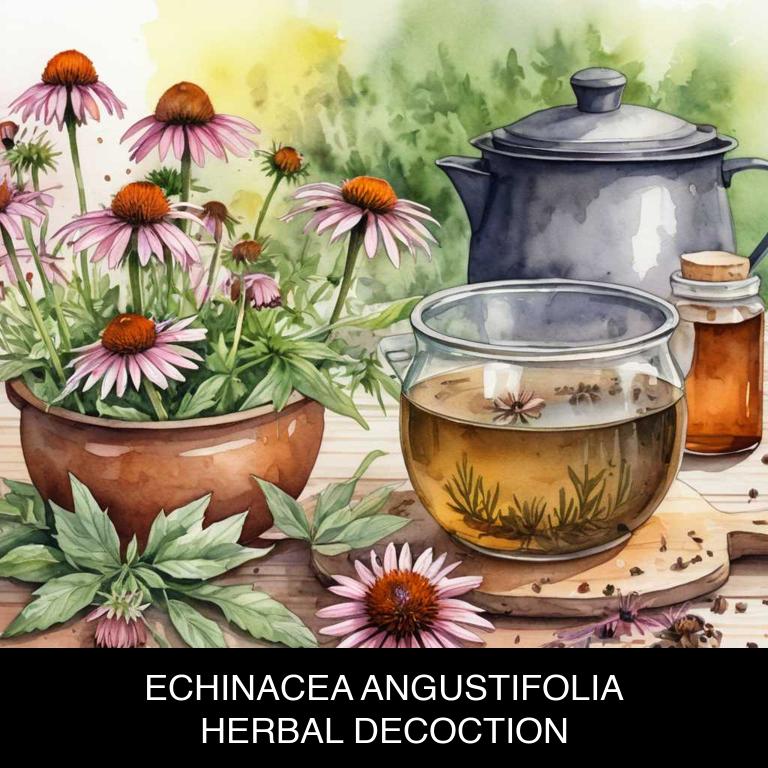
Medicinal Constituents
The list below shows the primary medicinal constituents in Echinacea angustifolia decoctions that help with phlegm.
- Iridoid glycosides: These compounds, particularly 6,7-dihydroxy-3-hydroxy-8-methoxy flavone, have been shown to exhibit anti-inflammatory and immunomodulatory effects, which can help alleviate phlegm-related respiratory issues.
- Alkylphenol glycosides: These compounds, such as alkylphenol-8-glucoside, have been found to possess anti-inflammatory and expectorant properties, helping to thin and expel phlegm from the respiratory tract.
- Tannins: Tannins, particularly those present in Echinacea angustifolia, have been found to exhibit astringent properties, which can help reduce mucus production and alleviate phlegm-related respiratory symptoms.
Parts Used
The list below shows the primary parts of kansas coneflower used to make decoctions for phlegm.
- Roots: Rich in compounds that help to reduce inflammation and relieve respiratory issues.
- Leaves: Contain antiviral properties that aid in reducing phlegm and congestion.
- Flowers: High in flavonoids and phenolic acids, which help to reduce inflammation and promote a clear respiratory system.
Quick Recipe
The following recipe gives a procedure to make a basic kansas coneflower for phlegm.
- Harvest the roots of echinacea angustifolia in late summer or early fall when they are mature and dry.
- Clean the roots thoroughly with water and then dry them in a cool dark place for 2 weeks.
- Chop 2-3 ounces of dried echinacea angustifolia roots into small pieces and add to a large pot.
- Pour 4 cups of boiling water over the chopped roots and steep for 10-15 minutes or until the liquid has reduced by half.
- Strain the decoction through a cheesecloth into a clean container and discard the solids.
7. Solidago virgaurea
Goldenrod decoctions helps with phlegm because of its natural expectorant properties, which make it an effective remedy for relieving congestion and coughs.
The herb's active compounds, such as flavonoids and phenolic acids, help to thin and loosen mucus in the respiratory tract, making it easier to expel. This allows for a clearer airway and reduced phlegm production, providing relief from respiratory issues like bronchitis, asthma, and allergies.
By promoting healthy mucus clearance, goldenrod decoctions can bring fast and natural relief from phlegm-related discomforts.
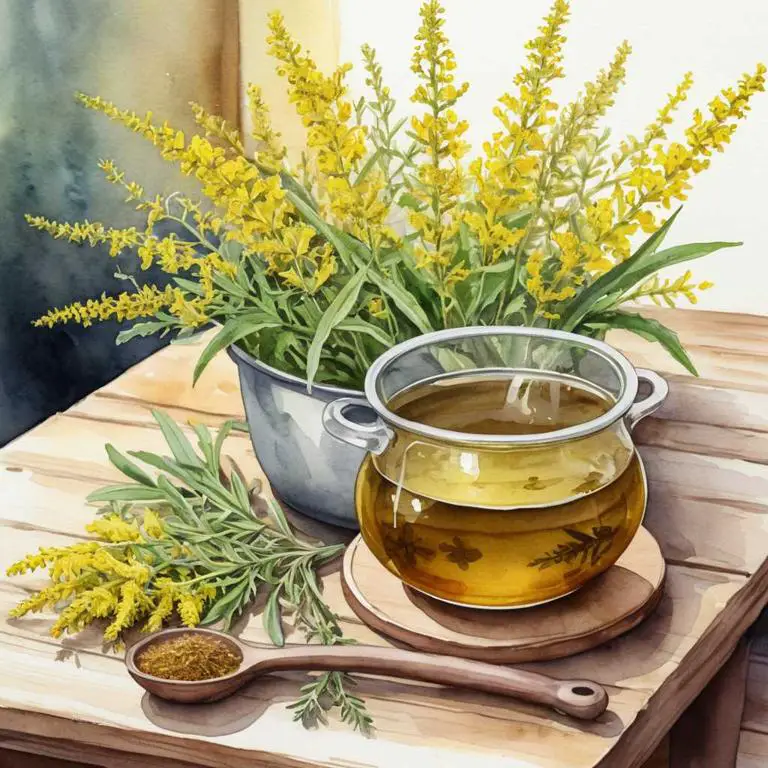
Medicinal Constituents
The list below shows the primary medicinal constituents in Solidago virgaurea decoctions that help with phlegm.
- Flavonoids: These constituents help with phlegm by exhibiting anti-inflammatory properties, reducing swelling and congestion in the respiratory tract.
- Lignans: Lignans in Solidago virgaurea decoctions help with phlegm by acting as an expectorant, promoting the expulsion of mucus and phlegm from the respiratory system.
- Phenolic acids: Phenolic acids in these decoctions help with phlegm by demonstrating antimicrobial properties, reducing the growth of microorganisms that contribute to phlegm accumulation.
Parts Used
The list below shows the primary parts of goldenrod used to make decoctions for phlegm.
- Leaves: They are used to make decoctions for phlegm due to their antispasmodic and expectorant properties.
- Flowers: The flowers are used in decoctions for phlegm because of their anti-inflammatory and antiseptic properties.
- Roots: The roots are used to make decoctions for phlegm due to their expectorant and diuretic properties.
Quick Recipe
The following recipe gives a procedure to make a basic goldenrod for phlegm.
- Harvest 20-30 grams of dried solidago virgaurea roots and leaves for decoction.
- Rinse the dried solidago virgaurea with cold water to remove any impurities.
- Combine the rinsed solidago virgaurea with 1 liter of water in a saucepan.
- Boil the mixture for 5-10 minutes or until the liquid reduces by half.
- Strain the decoction through a cheesecloth or a fine-mesh sieve to remove solids.
8. Mentha x piperita
Peppermint decoctions helps with phlegm because of its natural expectorant properties that loosen and clear mucus from the lungs and airways.
The menthol content in peppermint stimulates the respiratory system, releasing trapped phlegm and reducing congestion. Additionally, the anti-inflammatory compounds in peppermint soothe irritated mucous membranes, making it easier to expel excess mucus.
As a result, regular consumption of peppermint decoctions can provide fast relief from coughs, colds, and sinusitis-related phlegm buildup, promoting clear breathing and overall respiratory health.
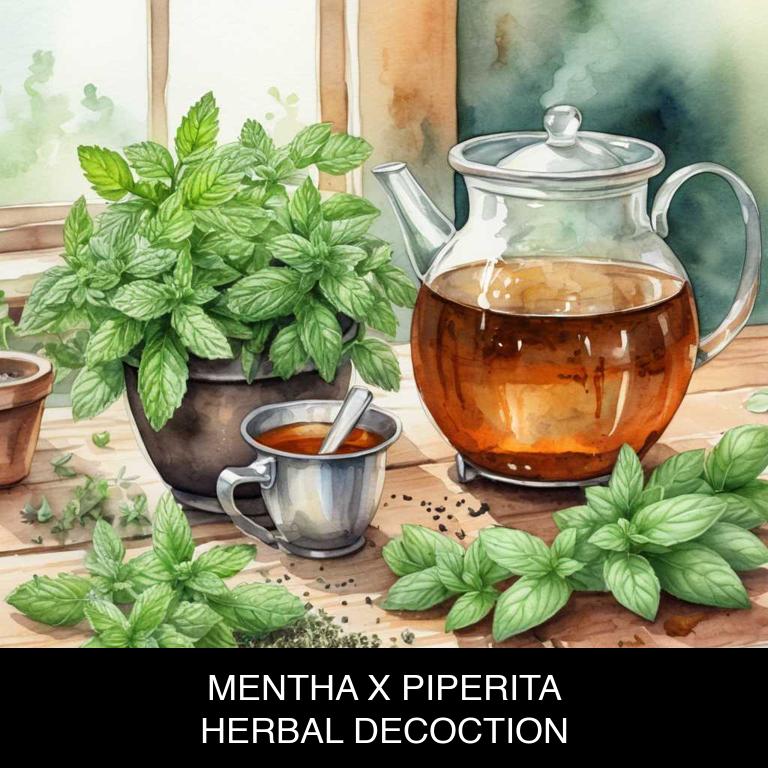
Medicinal Constituents
The list below shows the primary medicinal constituents in Mentha x piperita decoctions that help with phlegm.
- Menthol: Menthol helps to thin and expel mucus from the respiratory tract, thereby relieving congestion and cough associated with phlegm.
- Rosmarinic acid: Rosmarinic acid has anti-inflammatory and antioxidant properties that help to reduce inflammation and oxidative stress in the airways, making it easier to expel phlegm.
- Cineole: Cineole acts as an expectorant, helping to loosen and clear mucus from the lungs and airways, making it easier to cough up phlegm and relieve respiratory congestion.
Parts Used
The list below shows the primary parts of peppermint used to make decoctions for phlegm.
- Leaves: Their high menthol and menthone content helps to break down and clear phlegm from the respiratory system.
- Roots: The root's bitter compounds aid in digestion and help to reduce excess phlegm, making it easier to expel.
- Stems: The stems' menthol and other volatile oils help to thin and clear phlegm, relieving congestion and coughs.
Quick Recipe
The following recipe gives a procedure to make a basic peppermint for phlegm.
- Harvest 20-30 grams of fresh mentha x piperita leaves and flowers in the early morning when the dew is still present.
- Rinse the harvested mentha x piperita leaves and flowers with cool water to remove any dirt or debris.
- Chop the fresh mentha x piperita leaves and flowers into smaller pieces to increase their surface area for infusion.
- Steep 1 teaspoon of chopped mentha x piperita per 250 milliliters of boiling water for 5-7 minutes to release the active compounds.
- Strain the decoction through a cheesecloth or a fine-mesh sieve into a clean container to remove the solids.
9. Salvia officinalis
Sage decoctions helps with phlegm because of its natural expectorant properties, which loosen and clear out excess mucus from the respiratory tract.
The herb contains bioactive compounds like camphor, borneol, and thujone that help to reduce inflammation and congestion in the chest and throat.
Additionally, sage's antiseptic and antibacterial properties help to combat underlying infections that may be contributing to the production of phlegm, providing relief from coughs, colds, and other respiratory issues.
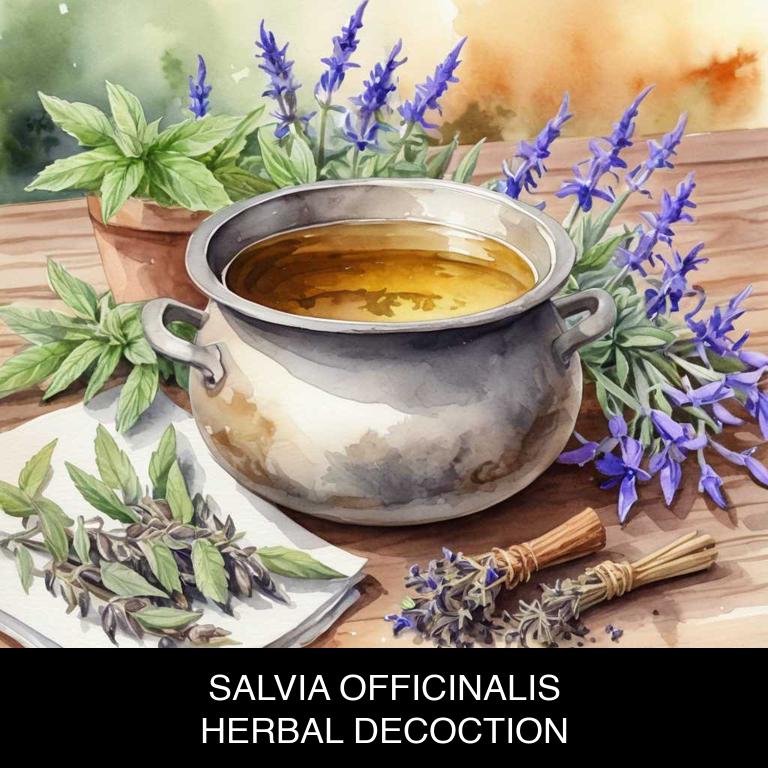
Medicinal Constituents
The list below shows the primary medicinal constituents in Salvia officinalis decoctions that help with phlegm.
- Tanshinone iia: A diterpenoid compound that helps reduce phlegm by inhibiting the production of pro-inflammatory cytokines and suppressing the proliferation of inflammatory cells.
- Ursolic acid: A triterpenoid compound that exhibits anti-inflammatory and expectorant properties, helping to reduce phlegm by relieving cough and promoting the expulsion of mucus.
- Rosmarinic acid: A phenolic compound that possesses anti-inflammatory and antioxidant properties, which helps to reduce phlegm by inhibiting the production of pro-inflammatory enzymes and promoting the clearance of mucus.
Parts Used
The list below shows the primary parts of sage used to make decoctions for phlegm.
- Leaves: They are the most commonly used part due to their high concentration of volatile oils and saponins, which have expectorant properties to help relieve phlegm.
- Stems: The stems are also used as a substitute for leaves, containing similar compounds that help to thin and expel mucus.
- Roots: Although less commonly used, the roots of Salvia officinalis can also be employed to create decoctions for phlegm relief, as they contain saponins and other compounds that aid in expectoration.
Quick Recipe
The following recipe gives a procedure to make a basic sage for phlegm.
- Harvest the dried salvia officinalis leaves and flowers to use in decoctions.
- Grind 1-2 teaspoons of the dried plant material into a fine powder using a mortar and pestle.
- Combine the ground plant material with 1 cup of boiling water in a heat-resistant glass cup.
- Steep the mixture for 5-7 minutes to allow the active compounds to infuse into the water.
- Strain the decoction through a cheesecloth or a fine-mesh sieve into a clean glass container.
10. Ginkgo biloba
Maidenhair tree decoctions helps with phlegm because of its unique properties that help to break down and expel excess mucus from the body.
The decoction's expectorant properties loosen and clear out congestion in the chest and sinuses, making it easier to breathe and reducing coughing fits.
Additionally, the antimicrobial compounds present in the maidenhair tree have anti-inflammatory effects that soothe irritated airways and reduce inflammation, allowing for a faster recovery from respiratory infections and allergies.
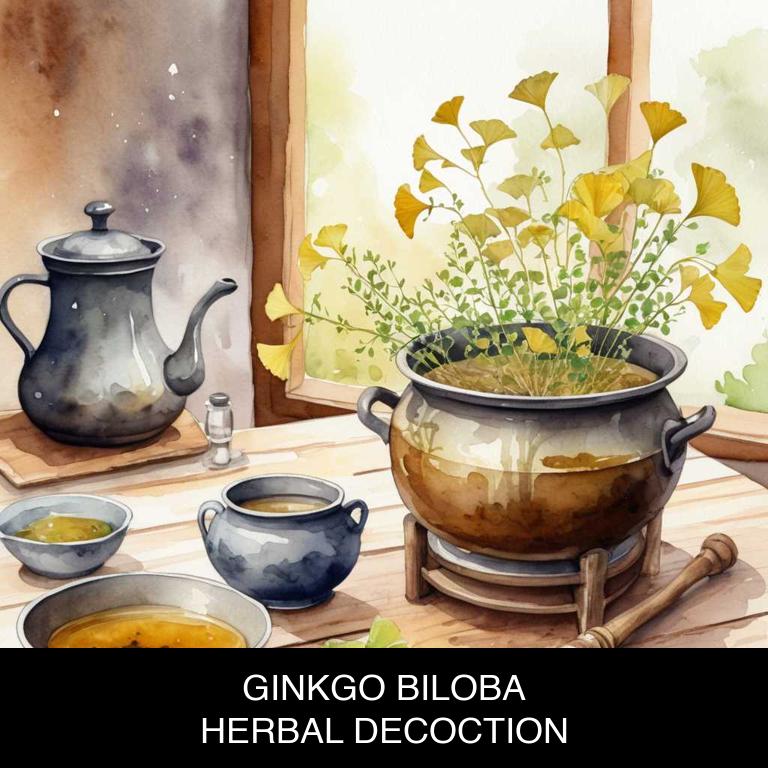
Medicinal Constituents
The list below shows the primary medicinal constituents in Ginkgo biloba decoctions that help with phlegm.
- Flavonoids: These compounds, particularly quercetin and kaempferol, help reduce inflammation and inhibit the production of mucus, making it easier to expel phlegm.
- Bilobalide: A sesquiterpene lignan, bilobalide has anti-inflammatory and antioxidant properties that can help break down and clear phlegm from the respiratory system.
- Ginkgolides: These sesquiterpene diterpenes, particularly ginkgolide A and B, have potent anti-inflammatory effects that can help reduce congestion and make it easier to expel phlegm from the lungs.
Parts Used
The list below shows the primary parts of maidenhair tree used to make decoctions for phlegm.
- Leaves: The leaves of Ginkgo biloba are most commonly used due to their high flavonoid content, which helps to break down and clear excess phlegm.
- Seeds: The seeds of Ginkgo biloba are also used as they contain bilobalide, which has anti-inflammatory properties that help to reduce phlegm and congestion.
- Buds: The buds of Ginkgo biloba are utilized for their medicinal properties, particularly in relieving respiratory issues such as coughs and congestion caused by excess phlegm.
Quick Recipe
The following recipe gives a procedure to make a basic maidenhair tree for phlegm.
- Measure 1-2 teaspoons of dried ginkgo biloba leaves per cup of water for decoction.
- Combine ginkgo biloba leaves with 1 cup of water in a saucepan and bring to a boil.
- Reduce heat to a simmer and let ginkgo biloba steep for 30-40 minutes.
- Strain the decoction through a fine-mesh sieve into a cup to remove ginkgo biloba leaves.
- Serve the decoction immediately after straining to preserve its bioactive compounds.
What is the best combination of herbal decoctions to use for phlegm?
The best combination of herbal decoctions that help with phlegm is a blend of Ginger (Zingiber officinale), Licorice Root (Glycyrrhiza glabra), and Thyme (Thymus vulgaris).
Ginger's anti-inflammatory properties help reduce congestion, while Licorice Root soothes and calms the respiratory tract. Thyme's expectorant properties aid in the removal of phlegm, promoting easier breathing. Together, these decoctions create a harmonious blend that effectively tackles phlegm, providing relief from congestion and promoting overall respiratory health.
This combination can be consumed as a warm tea.
What ailments similar to phlegm are treated with herbal decoctions?
Ailments similar to phlegm/decoctions.html">phlegm/decoctions.html">phlegm that are treated with herbal decoctions are respiratory issues such as bronchitis, asthma, and chronic coughs.
Additionally, herbal decoctions can help alleviate symptoms of sinusitis, rhinitis, and laryngitis.
They also effectively treat digestive problems like bloating, constipation, and indigestion, which can be attributed to an imbalance of bodily humors.